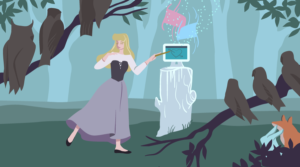Introduction
Node.js is a server side JavaScript execution environment. It’s a platform built on Google Chrome’s V8 JavaScript runtime. It helps in building highly scalable and concurrent applications rapidly. Express is lightweight framework used to build web applications in Node. It provides a number of robust features for building single and multi page web application. Express is inspired by the popular Ruby framework, Sinatra. MongoDB is a schemaless NoSQL database system. MongoDB saves data in binary JSON format which makes it easier to pass data between client and server. AngularJS is a JavaScript framework developed by Google. It provides some awesome features like the two-way data binding. It’s a complete solution for rapid and awesome front end development. In this article, we’ll be creating a simple CRUD application using the MEAN stack. So, let’s dive in.Prerequisites
Before getting started, we need to install the various MEAN software packages. Begin by installing Node.js from the download page. Next, install download and install MongoDB. The install MongoDB page contains guides for setting up Mongo on a variety of operating systems. To make things easier, we’ll be starting from a MEAN boilerplate project. Simply clone the boilerplate repo and install the dependencies using npm as shown in the following listing.git clone http://github.com/linnovate/mean.git
cd mean
npm install27017 as specified in the README file of the boilerplate. Open up the file /etc/mongodb.conf and uncomment the line port = 27017. Now, restart the mongod server as shown below.
mongod --config /etc/mongodb.confgrunt. If all goes well, you will see a message like this:
Express app started on port 3000http://localhost:3000/ in a browser to see the boilerplate app running.
Boilerplate Overview
We now have a fully functional boilerplate application. It has authentication implemented, including using social media login. We won’t be going much into that, but will be creating our own little app. If you have a look at the application structure, thepublic
folder contains our AngularJS front end and the server folder contains our NodeJS backend.
Creating a Listing View
First, let’s start by creating our front end using AngularJS. Navigate to thepublic folder. Create a new folder called bucketList, where we’ll keep our front end files. Inside the bucketList directory, create subdirectories named controllers, routes, services, and views. Inside the bucketList folder also create a file named bucketList.js containing the following code.
'use strict';
angular.module('mean.bucketList', []);mean/public/init.js and add the module mean.bucketList. The modified portion should look like this:
angular.module('mean', ['ngCookies', 'ngResource', 'ui.bootstrap', 'ui.router', 'mean.system', 'mean.articles', 'mean.auth', 'mean.bucketList']);public/bucketList/routes and add the bucketList.js route file to handle routing in our app. The code to accomplish this is shown below.
'use strict';
//Setting up route
angular.module('mean.bucketList').config(['$stateProvider', '$urlRouterProvider',
function($stateProvider, $urlRouterProvider) {
// states for my app
$stateProvider
.state('all bucket list', {
url: '/bucketList',
templateUrl: 'public/bucketList/views/list.html'
});
}
]);public/bucketList/views/ create a file named list.html. This is our view, which will display our bucket list. The contents of this file are shown below.
<section data-ng-controller="BucketListController">
Welcome to the bucket list collection
</section>bucketList.js inside public/bucketList/controllers containing the following code.
'use strict';
angular.module('mean.bucketList').controller('BucketListController', ['$scope', '$stateParams', '$location', 'Global',
function($scope, $stateParams, $location, Global) {
$scope.global = Global;
}
]);grunt
. Make sure that MongoDB is running too if it’s not already. Navigate your browser to http://localhost:3000/#!/bucketList, and you should see the list view that we created. If you are wondering about the #! in the url, it’s just done to separate the AngularJS and NodeJS routing.
Add to the Bucket List
Let’s create a view to add things to our bucket list. Insidepublic/bucketList/views add a new HTML file named create.html containing the following code.
<section data-ng-controller="BucketListController">
<form class="form-horizontal col-md-6" role="form" data-ng-submit="create()">
<div class="form-group">
<label for="title" class="col-md-2 control-label">Title</label>
<div class="col-md-10">
<input type="text" class="form-control" data-ng-model="title" id="title" placeholder="Title" required>
</div>
</div>
<div class="form-group">
<label for="description" class="col-md-2 control-label">Description</label>
<div class="col-md-10">
<textarea data-ng-model="description" id="description" cols="30" rows="10" placeholder="Description" class="form-control" required></textarea>
</div>
</div>
<div class="form-group">
<div class="col-md-offset-2 col-md-10">
<button type="submit" class="btn btn-default">Submit</button>
</div>
</div>
</form>
</section>BucketListController controller. Also note that on form submit, a method named create() is invoked. Next, let’s create a method named create() in the BucketListController. The following code must be added to public/bucketList/controllers/bucketList.js, as shown below. We have injected the BucketList service in the controller, which we need to interact with the back end.
'use strict';
angular.module('mean.bucketList').controller('BucketListController', ['$scope', '$stateParams', '$location', 'Global', 'BucketList',
function ($scope, $stateParams, $location, Global, BucketList) {
$scope.global = Global;
$scope.create = function() {
var bucketList = new BucketList({
title: this.title,
description: this.description
});
bucketList.$save(function(response) {
$location.path('/bucketList');
});
};
}
]);public/bucketList/services/bucketList.js are shown below.
'use strict';
angular.module('mean.bucketList').factory('BucketList', ['$resource',
function($resource) {
return $resource('bucketList);
}
]);public/bucketList/routes/bucketList.js, adding one more state as shown below.
'use strict';
//Setting up route
angular.module('mean.bucketList').config(['$stateProvider', '$urlRouterProvider',
function($stateProvider, $urlRouterProvider) {
// states for my app
$stateProvider
.state('all bucket list', {
url: '/bucketList',
templateUrl: 'public/bucketList/views/list.html'
})
.state('add bucket list', {
url: '/addBucketList',
templateUrl: 'public/bucketList/views/create.html'
})
}
]);http://localhost:3000/#!/addBucketList. You should see the bucket list creation form. Unfortunately, it’s not yet functional. We need to create the back end too.
Creating the Back End
The bucket list should have a title, description, and status. So, create a new file calledbucketlist.js in server/models/bucketlist.js, and add the following code.
'use strict';
/**
* Module dependencies.
*/
var mongoose = require('mongoose'),
Schema = mongoose.Schema;
/**
* Bucket List Schema
*/
var BucketListSchema = new Schema({
created: {
type: Date,
default: Date.now
},
title: {
type: String,
default: '',
trim: true
},
description: {
type: String,
default: '',
trim: true
},
status: {
type: Boolean,
default: false
}
});
mongoose.model('BucketList', BucketListSchema);server/routes/bucketList.js containing the following code.
'use strict';
var bucketList = require('../controllers/bucketList');
module.exports = function (app) {
app.post('/bucketList', bucketList.create);
};POST
requests to /bucketList are handled by the bucketList.create() method. This method belongs in the server controller, bucketList.js, that we still need to create. The contents of server/controllers/bucketList.js should look like this:
'use strict';
/**
* Module dependencies.
*/
var mongoose = require('mongoose'),
BucketList = mongoose.model('BucketList');
/**
* Create an Bucket List
*/
exports.create = function(req, res) {
var bucketList = new BucketList(req.body);
bucketList.save(function(err) {
if (err) {
console.log(err);
} else {
res.jsonp(bucketList);
}
});
};create() method, which then inserts the data into MongoDB.
After submitting the form, we can check if the data is properly inserted into Mongo. In order to check data in MongoDB, open another terminal and issue the following commands.
mongo // Enter the MongoDB shell prompt
show dbs; // Shows the existing Dbs
use mean-dev; // Selects the Db mean-dev
show collections; // Show the existing collections in mean-dev
db.bucketlists.find() //Show the contents of bucketlists collectionCreating the Bucket List View
First, add a new route inserver/routes/bucketList.js:
app.get('/bucketList', bucketList.all);all() method. Add this method to server/controllers/bucketList.js, as shown below. This code finds the entries in the bucketList collection and returns them.
exports.all = function(req, res) {
BucketList.find().exec(function(err, bucketList) {
if (err) {
console.log(err);
} else {
res.jsonp(bucketList);
}
});
};public/bucketList/controllers/bucketList.js as shown below.
$scope.getAllBucketList = function() {
BucketList.query(function(bucketList) {
$scope.bucketList = bucketList;
});
};$scope.bucketList variable. Now, we just need to bind it to our HTML. This is done in public/bucketList/views/list.html:
<section data-ng-controller="BucketListController" data-ng-init="getAllBucketList()">
<ul class="bucketList unstyled">
<li data-ng-repeat="item in bucketList">
<span>{{item.created | date:'medium'}}</span> /
<span>{{item.title}}</span>
<div>{{item.description}}</div>
</li>
</ul>
<a href="/#!/addBucketList">Create One</a>
</section>http://localhost:3000/#!/bucketList. This should display the bucket list items. You can also try adding new items by clicking on the “Create” link below the list.
Conclusion
In this article, we focused on creating a simple app using the MEAN stack. We implemented adding an entry into MongoDB and displaying the entries from the DB. If you’re interested in extending this example, you can try adding the update and delete operations. The code from this article is available on GitHub.Frequently Asked Questions (FAQs) about MEAN Stack
What are the key differences between MEAN Stack and Full Stack development?
While both MEAN Stack and Full Stack development involve working with both the front-end and back-end of web applications, there are some key differences. MEAN Stack refers to a specific set of technologies – MongoDB, Express.js, Angular.js, and Node.js. These are all JavaScript-based, which means MEAN Stack developers only need to use one language across all layers of a project. On the other hand, Full Stack development is more general and can involve a variety of different technologies, not just those in the MEAN Stack.
Why should I choose MEAN Stack for my project?
MEAN Stack offers several advantages. Firstly, since it’s JavaScript-based, it allows for seamless integration between client-side and server-side, leading to efficient and speedy development. Secondly, all components of MEAN Stack are open-source, meaning they are free to use and regularly updated by their developer communities. Lastly, MongoDB, a component of MEAN, is a NoSQL database, which can handle large amounts of data and is highly scalable.
What is the role of MongoDB in MEAN Stack?
MongoDB is the database system used in MEAN Stack. It’s a NoSQL database, which means it can handle unstructured data in a flexible, JSON-like format. This makes it a good fit for web applications that need to handle large amounts of diverse data. MongoDB also integrates well with Node.js, making it a natural fit for the MEAN Stack.
How does Express.js contribute to MEAN Stack?
Express.js is a back-end web application framework for Node.js. It provides a robust set of features for web and mobile applications, making it easier to build single-page, multi-page, and hybrid web applications. Express.js simplifies the process of writing server code, as it has built-in methods for routing, middleware configuration, and template engines.
Can I use another database system instead of MongoDB in MEAN Stack?
While MongoDB is the default database system in MEAN Stack, it’s possible to use another database system. However, this would technically no longer be “MEAN” Stack, as the acronym stands for MongoDB, Express.js, Angular.js, and Node.js. The choice of database system depends on the specific needs and constraints of your project.
What is the learning curve like for MEAN Stack?
As with any technology stack, the learning curve for MEAN Stack can be steep, especially if you’re new to programming. However, one advantage of MEAN Stack is that all its technologies are based on JavaScript, so you only need to learn one language. There are also plenty of resources and tutorials available online to help you get started.
How does MEAN Stack compare to other technology stacks?
MEAN Stack is often compared to other technology stacks like LAMP (Linux, Apache, MySQL, PHP) or MERN (MongoDB, Express.js, React.js, Node.js). One key advantage of MEAN Stack is its uniformity – all technologies in the stack are JavaScript-based. This can lead to more efficient development and easier maintenance. However, the best technology stack depends on the specific needs of your project.
Is MEAN Stack suitable for large-scale projects?
Yes, MEAN Stack is suitable for large-scale projects. MongoDB, a component of MEAN, is a NoSQL database that can handle large amounts of data and is highly scalable. Node.js, another component, is known for its high performance and scalability. However, as with any technology stack, it’s important to consider the specific needs and constraints of your project.
What kind of applications can be built with MEAN Stack?
MEAN Stack is versatile and can be used to build a variety of web applications, including single-page applications, social networking sites, and complex business applications. Its components are powerful and flexible, allowing developers to create rich, interactive user interfaces.
How is data handled in MEAN Stack?
In MEAN Stack, data is handled using MongoDB, a NoSQL database. This means it can handle unstructured data in a flexible, JSON-like format. Data can be easily passed between client and server using JSON, and MongoDB’s document-oriented structure makes it easy to store and retrieve data.
 Jay Raj
Jay RajJay is a Software Engineer and Writer. He blogs occasionally at Code Handbook and Tech Illumination.




